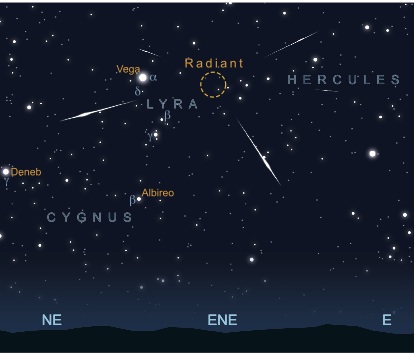



|

|

Return of the Lyrids
BY MARK ARMSTRONG
ASTRONOMY NOW
Posted: 18 April 2013

After a seemingly interminable drought, meteor enthusiasts can finally get some action with the return of the Lyrids, active between 18 and 25 April with the peak of maximum activity expected at 11h UT on 22 April.

You can find the radiant near the constellations Lyra and Hercules.
Observers in dark, transparent skies can expect to see between 10-20 meteors an hour if the Moon is out of the way, but unfortunately 2013's show will be blighted somewhat by the presence of a waxing gibbous moon. However, Lyrids can often be bright events, even blinding fireballs, that can leave persisting ionization trails which can punch through washed out, moonlit skies.
Very occasionally, the Lyrids can dazzle, with rates climbing as high at 100 per hour for short timespans, as happened in 1922 and 1982. So it's always worth making the effort to observe.
The Lyrids are spawned by comet 1861 G1 (Thatcher), the Earth passing through the stream of debris left along its orbit every year in April. The area on the sky where the meteors appear to come from is called the radiant and for the Lyrids it lies eight degrees south-west of brilliant Vega, actually inside Hercules' boundary. For UK observers, the predicted timing of maximum is not favourable so it's best to try to observe on the nights of April 21/22 and 22/23. The radiant will have risen above 30 degrees in the east-northeast by 11pm but the pesky Moon will be in the south-southwest in Sextans on the first night, setting by around 3.40am BST, and be in southern Leo on 22/23rd, setting by 4am. This leaves a small moon-free window of opportunity before the morning twilight is upon us.
Observers in the USA are favoured with the predicted maximum occurring on 21/22 April around 4am local daylight savings time on the west coast. From Los Angeles, the radiant is well up by midnight and the Moon has set by 4am, leaving about an hour to enjoy the meteors with the radiant overhead.
|

|

|

|
|



